Zane has been out touring on the updated Kawasaki H2 SX, It's safe to say he enjoyed the most powerful touring bike in the world... Photos: Zane Dobie & Impact Photography.
Never in my career have I considered putting in an offer to buy a motorcycle after testing it. Sometimes the price is too high, sometimes I struggle to see the use in them and sometimes they’re just not my style. The 2022 Kawasaki Ninja H2 SX ended that streak.

Zane finally found out what a bitter goodbye was to a motorcycle he didn’t even own! Check out what he had to say about the 2022 Kawasaki Ninja H2 SX.
My H2 story starts a few years back, I was 18 and studying Journalism at Uni. I was working at a motorcycle magazine as the “Staff Journalist” which was more running around taking lunch orders, replying to fan/hate mail, and writing the odd news/lifestyle story here and there.
Check out our review of the previous H2 SX here…
One day, the editor needed help moving bikes to and from a photo location about five minutes away. No one else must’ve been in the office that day as I was thrown the keys to the previous generation H2 SX and told to be careful. Keep in mind, I hadn’t even worked my way up to testing my first bike yet and I was putting around on a little 250.
When you’re 18, you are not thinking “Far out, I’ve just been trusted with one of the most powerful bikes on the market, better take it easy.” You instead sit there and think about how you can make it to the photo spot and get a small joy ride in. Instead of going straight there, I took it for a quick zip up the freeway and twisted the throttle on all the way. It scared the absolute s*** out of me as the front wheel flung up in the air and I rattled through the gears, trying to stay on it.
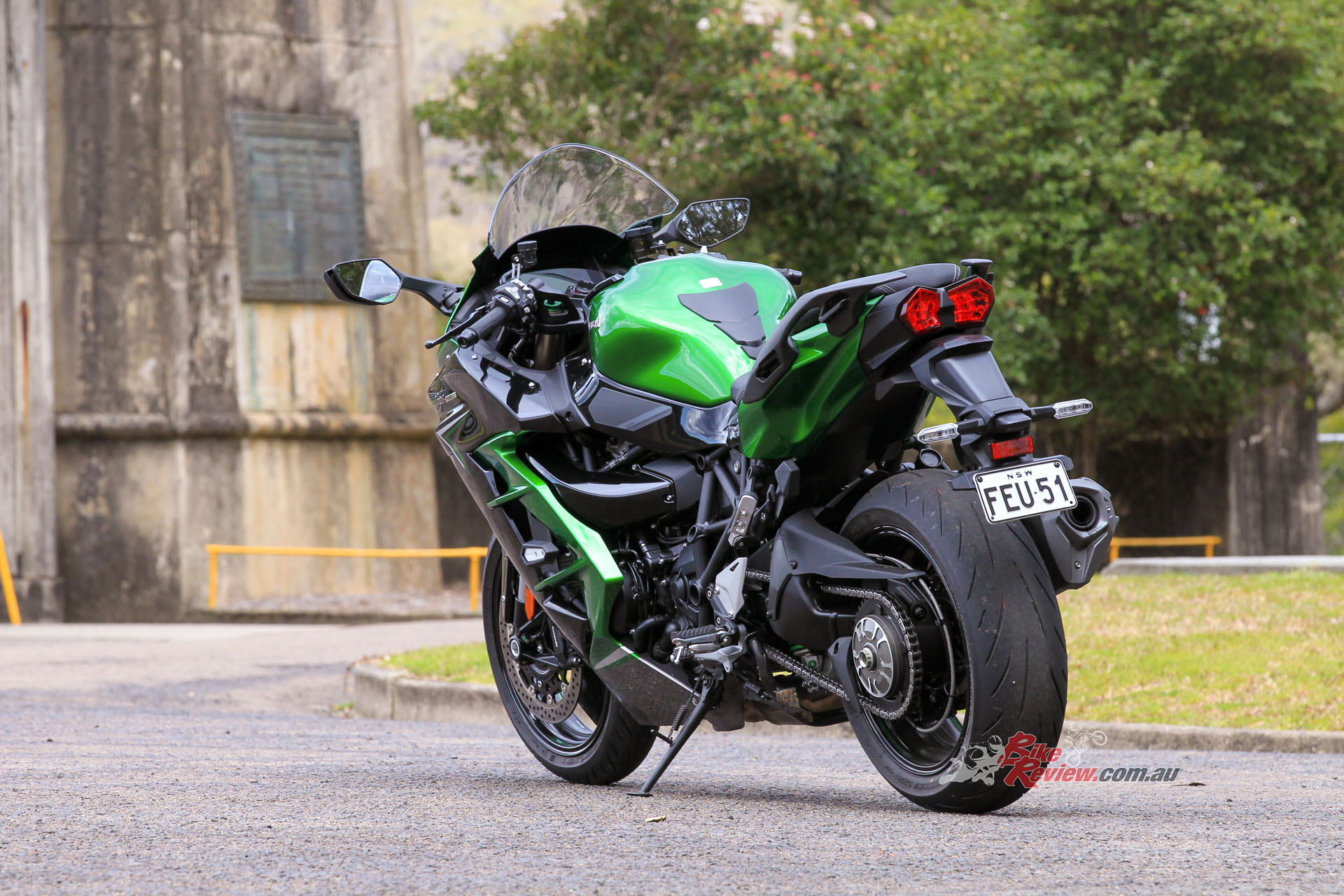
Despite an aggressive stance the H2 SX is marketed as a touring machine, you wouldn’t believe it without out the panniers attached. But it is a sports tourer through and through.
Since then, a bike has never sent shivers through my body as the H2 did when the wastegate chattered letting off the throttle and me being too anxious to even look down at the speedo. When the call came to test the new model, I jumped at the opportunity to look at it from a mature point of view.
“Kawasaki are on another level when it comes to their paint. I’m such a sucker for heavy amounts of flake and the green explodes in the sun…”
Rolling into the Kawasaki Australia HQ, I’m itching with excitement, my brain is filled with the sound of H2 sound compilations on YouTube. I’ll usually go into a test with no expectations, but the H2 SX is different, the tech articles about it make it sound like a revolutionary machine. I can safely state that Kawasaki were humble when talking about this spectacular bike.
First walk around and far out, what an exciting looking sport touring machine. The full fairing with pointy lines and angry air-ducts really accentuate thoughtful and practical design. Kawasaki are on another level when it comes to paint too. I’m such a sucker for heavy amounts of flake and the green explodes in the sun the same way the paint on the 50th anniversary Z650RS I tested recently does.
The test model didn’t have the panniers attached, which assisted in taking away some of the bulkiness of this massive motorcycle, but we had to use a backpack to get around, not ideal for sports touring.

“Time to take off and I’m instantly blown away by how something with the title of “world most powerful touring motorcycle” could be this easy to ride at slow speeds.”
Time to take off and I’m instantly blown away by how something with the title of World’s Most Powerful Touring Motorcycle could be this easy to ride at slow speeds. Alas, I’m immediately tempted to crank the throttle on all the way and let the supercharger wind up but I’m thinking about the story a fellow journalist told me as he got caught at 200km/h about 5 minutes into his test on the previous H2 SX!
Usually, I’d be raving on about how the engine is my favourite part of the bike but there are so many aspects that Kawasaki have done right when it comes to the 2022 model that it almost shadows the mind-blowing engineering that went into developing the powerhouse.

“The power is addictive and the sound is next level. Releasing all 147kW, with more experience than my first time on the H2, it’s still borderline scary.”
The power is addictive and the sound is next level. Releasing all 147kW, with more experience than my first time on the H2, it’s still borderline scary. All assists turned up to the max and I’m still holding on for dear life as the supercharger winds all the boost on until the motor is bouncing off the rev-limiter, me ready to feed it another gear and reach dizzying speeds.
The supercharger makes some of the most insane sounds, when you come off the throttle, the wastegate will chatter almost until idle. While the EURO5 muffler silences the exhaust note quite heavily, I prefer the sound of the wastegate much more to a loud exhaust. I’m not going to lie, I’d probably throw the most obnoxious blow-off valve I could find if I owned the bike and leave the stock silencer on…
“Having forced-induction on a touring bike adds another level of enjoyment to a motorcycle category plagued with boring and soul-less machines.”
Having forced-induction on a touring bike adds another level of enjoyment to a motorcycle category plagued with boring and soul-less machines. The supercharger will only wind-up enough higher up in the rev-range, so you’re left with compliant and smooth characteristics down low. I have no idea how Kawasaki have managed to make the boost this easy to manage.
This compliant character is of course matched well with the slipper and assist clutch similar to most of Kawasaki’s range, one of the consistently best clutches you’ll find, no matter if it’s on their 47kW LAMS bikes or the H2. I do have to pick on something though, the quickshifter is quite notchy and noticeably slower than sportsbikes from other brands. But hey! It’s still awesome on a touring bike.

The slipper and assist clutch makes for easy rideability at low-speeds. Managing that 147kW excellently!
You can change the engine maps to a one of three different power outputs, which completely transforms the bike. I’m often inclined to just chuck bikes in their highest output mode, but the H2 SX gets quite wild in F power mode. The middle engine map M is still madly quick but adds even more of that low-down rideability!
I’ll admit that I did spend quite some time just revving the bike out in low gears just to hear the wastegate chatter. But, this thing is thirsty. The range would plummet while thrashing it and I can’t think of any other bike I filled up more than the H2 SX during a two-week test. Kawasaki claim 5.4L/100km but it is more like 7-7.5L/100km (Jeff got 6.9 – 10L/100km in his 2018 review). Who cares though, it’s all about smiles per gallon when you’ve got a supercharger!

Keep in mind that the H2 SX will drink petrol like crazy if you’re going to thrash it all the time….
Enough about the engine, I could go on for hours about how amazing it is but Jeff has already sung it’s praises in earlier tests. Now for the real star of the show, the electronics. When I’m not on bikes, I’m testing cars and a lot of the technology seen on the H2 SX has graced the car world for years, however Kawasaki are the first to fully apply it to motorcycles.
Starting with the most obvious change just by looking at the bike, the 2022 H2 SX features adaptive cruise control (ACC). Using a radar hidden in the nose-cone, when you set the cruise control, the bike will automatically reduce speed while approaching a car in-front.
The system works quite well but I’m not too stoked on the space of intervention, especially in Australia where it seems to be a trend to travel down the freeway at 25km/h under the speed limit. You can change the distance the radar allows through the dash, but even the closest setting is quite far away.

Sensors on the front and back of the bike make things like adaptive cruise control and blind-spot indicators possible.
The front radar is also used to detect an accident about to happen, if the bike senses an imminent accident, it’ll start flashing red up on the screen. Awesome for when you’re glaring at the speedo to ensure you don’t lose a few hundred bucks to one of the speed cameras that are seemingly every few km. Again though, it will freak out if you get too close to a car in front.
Now, the rear radar is bloody awesome. I’ve head-checked before and had cars seemingly appear out of nowhere when I go to change lanes. The rear radar will sense if a car is sitting in your blind-spot and show a small orange triangle on the side mirrors. A feature that has been on cars for years yet Kawasaki are the first to put it on a bike.
The only issue I have with the rear radar is that it’s contained within the chunky ADR approved plater holder, the first thing that gets replaced on my personal bikes. Does this mean you have to choose between blind-spot indicator and a tail tidy?
New for 2022 is the TFT dash, this thing is more like a tablet, its huge! The operating system is often something I will complain about, yet Kawasaki made the whole setup quite simple and beyond easy to use. All the settings are straightforward to adjust, while your dash config can be made as simple or comprehensive as you like it.
The Kawasaki SPIN app isn’t the best and not user friendly though, you have to leave your phone unlocked to use it and even then it’s quite basic. You can’t control any third party audio apps like Spotify through it. This is why we need something like Apple CarPlay or Andriod Audio for bikes as those systems update as phones do, ensuring that the software is not dated.

There are plenty of rider assists to muck around with. Set them to personal preference dependant on what kind of riding you’ll be doing!
I spent a few days in the road rider profile, getting a feel for the assists in their standard form before I decided it’s time to muck around. The six-axis IMU system is so good, the assists do not have noticeable invention when switched on. Sitting down with a cup of tea as I read the owners manual and to set up the custom profile, I set the Rider mode to all assists off and the bike transformed into an absolute wild animal. With no assists, the engine is what I’d imagine the light switch power of a 500cc two-stroke GP bike is like, if the front wheel isn’t in the air, the rear tyre is spinning.
“I set the Rider mode to all assists off and the bike transformed into an absolute wild animal…”
Yes, it is quite fun as the bike tried its best to throw me off, but maturity kicks in and at the absolute minimum, you should really just switch a low TCS to which the H2 SX is more than compliant and allows the front wheel to come up plenty while revving it out.
The levels of intervention with the traction control are spot on. I like my TCS set for medium intervention on most bikes as it allows for some rear wheel slip and small power wheelies without any hairy situations. However, I did have two moments hitting the local twisties while they were still patchy. Just corner exit and that lightswitch supercharged mid-range power made the bike snap into a slide before the TCS put me back in line.

“It’s a strange feeling coming off the throttle with the KEBC set to low and feeling a four-stroke compensate for engine braking, just like coming off the throttle of a two-stroke and rolling into a corner.”
The engine brake control is another aspect that further cemented the engine characteristics as what can only be described as two-stroke inspired. It’s a strange feeling coming off the throttle with the KEBC set to low and feeling a four-stroke compensate for engine braking, just like coming off the throttle of a two-stroke and rolling into a corner, there’s nothing there but your actual brakes. I do think it’s a feature you’ll rarely change on a touring bike, but when you’ve got a plethora of controls already on the bike, you may as well add it.
Another assist that made its way from the car world is the VHA (vehicle hold assist). Being that the bike is 260kg without panniers, the fact that Kawasaki added hill-stop assist shows that they listen to their customers. The VHA making taking off from the lights on hills an absolute breeze, you simply push down slightly harder on the rear brake and it’ll lock it on until you start to move. Allowing you to place both feet down for a stable take off.
Other gadgets included launch control (which I couldn’t figure out how to activate), Emergency Stop Signals that flash your rear lights during sudden stops, cornering lights and the dreaded keyless system. I’m disappointed with the keyless start system as during the photo shoot, I gave the key to the photographer while my backpack was off and there were zero warnings that I had ridden off without the key, it wasn’t a short distance too so losing the key out of your pocket and not being able to restart your bike is a real possibility. Plus, you still had to pull the key out to unlock the tank, which you’ll be doing a lot of, strange!

“You don’t sit like you would a sportsbike, the rider triangle is closer to a nakedbike than anything as the seat is quite low and the ‘bars are higher than conventional clips-on.”
The chassis is an interesting one, touring on it is awesome and it compliments that supercharged powerhouse so unbelievably well. You don’t sit like you would a sportsbike, the rider triangle is closer to a nakedbike than anything as the seat is quite low and the ‘bars are higher than conventional clips-on.
Suiting up in leathers on the road, something I rare do, I’m ready to experience what a 260kg touring bike feels like through slow and tight turns. What I begin to notice in the first few corners is that weight again, the bike is tough to tip into corners and really wants to stay upright. It’s quite a weird sensation as you expect it to fall from side to side by you just end up climbing off the bike in a bid to get it to lean.
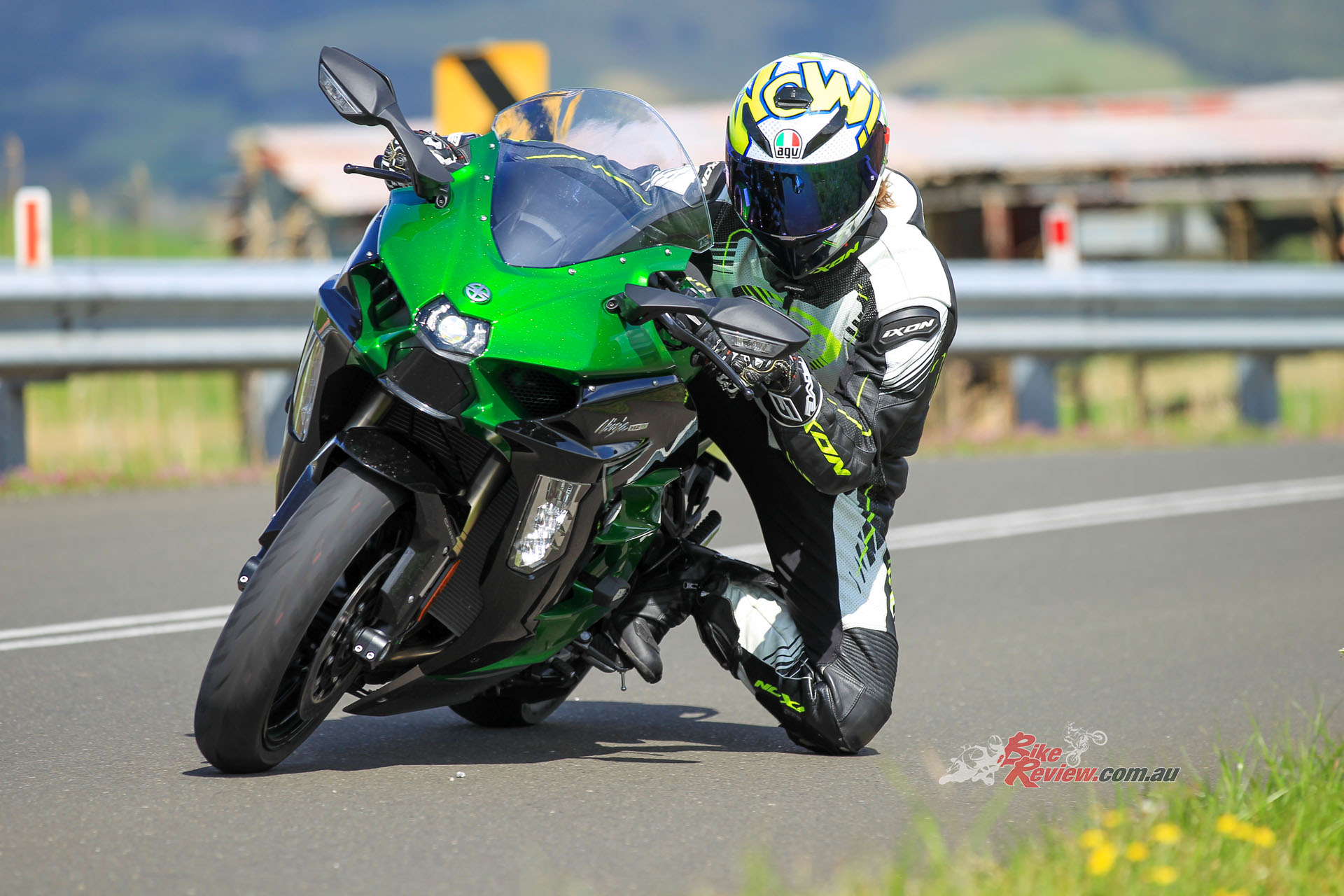
Zane noted that the H2 SX preferred to stay upright through the twisties. The low seat will allow you to hang off the bike plenty though.
I’m by no means saying that it’s not fun for a weekend blast but don’t expect it to handle the same way as a ZX-10R. The H2 SX could benefit from a steering damper, as I drop the front down from a wheelie, the bike starts to get unsettled. While it corrects itself, it’s something that a steering damper would help (it’s a bike that tends to have the front tyre skimming the surface quite often when riding hard, due to the power delivery and soft suspension).
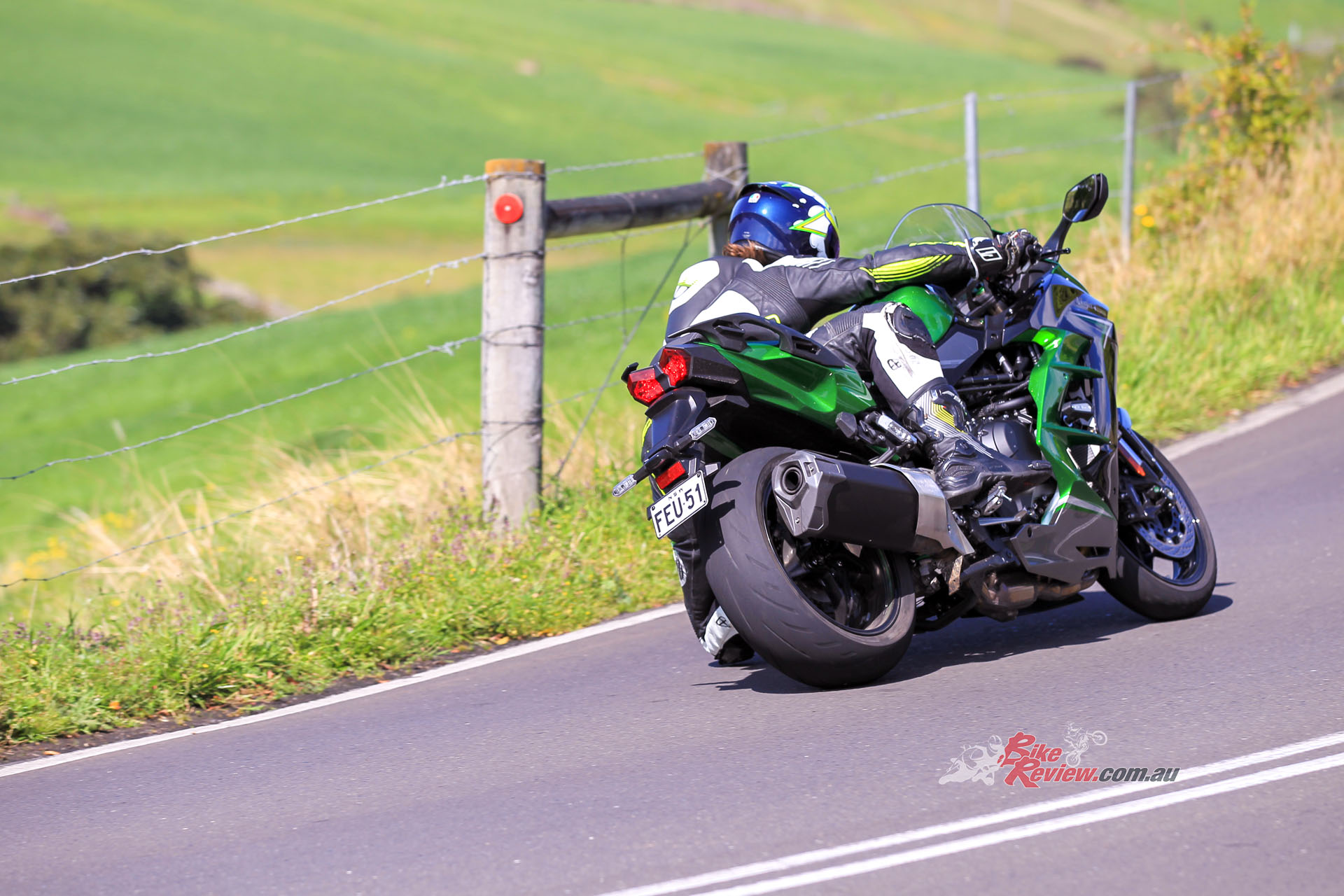
“It’s quite a weird sensation as you expect it to fall from side to side by you just end up climbing off the bike in a bid to get it to lean.”
The suspension feels as if it has been setup with comfort in mind. The stock setting on the USD forks are awesome while touring but hitting the twisties has me considering stiffening the front-end up, it’s just the weight that exaggerates things such as diving under braking and compression as the front wheel comes down from a wheelie.
The rear end is spectacular for a non-active setup. The only bikes above the H2 SX in terms of rear shock all use electronic setup, which really sings the praises that Kawasaki have made to the rear shock in 2022. Touring is no worries and even getting to the twisties, the setup is just spectacular, I didn’t know stock setting on a rear shock could be this good!

“The only bikes above the H2 SX in terms of rear shock all use electronic setup, which really sings the praises that Kawasaki have made to the rear shock in 2022.”
For touring and twisties, active suspension would shine on this bike. Kawasaki have KECS (Kawasaki Electronic Control Suspension) and it’s quite strange that they haven’t added it to the H2 SX. Given the low ride-away price, they could’ve tacked on another $10k and added active suspension as an option while still offering a good price.
The massive front brakes work well to stop the behemoth of a machine. I will note that there is a noticeable amount more intervention from the ABS compared to a sportsbike but those front discs didn’t seem to get tired after hours of thrashing. The rear brake I’m tempted to get my tools on to adjust it, I use a lot of rear brake while at slow speed and I find myself pushing the lever down with more force than other bikes to control that low speed manoeuvrability.

Zane said there are very few bikes that have left such a last impact on him like the 2022 H2 SX did.
I could yap on for hours about how good this bike is. When people ask me what my favourite bike I’ve ridden is, the 2022 H2 SX is on the very short list I tell them. The price is fair and I can’t think of a bike that has this spectacular of an engine combined with the extensive electronics that can beat a $35,947 rideaway tag. The suspension, while extraordinary, and weight, which is understandable given the category it fits into, are the only two things that let it down from a perfect score, an option with electronic suspension would have cemented the H2 SX into top spot best bike I’ve ridden.
The H2 SX is the only press bike I’ve serious sat down and considered dipping into my savings to buy instead of giving it back to Kawasaki. It’s in a league of its own in so many aspect’s that the only thing that held me back from buying it is my bank account.
Kawasaki H2 SX Electronics Systems
The updated Ninja H2 SX features a number of technological firsts. It’s completely revised core system includes an FI-ECU with torque-demand capabilities, a new IMU that measures in all six DOF; and a compact, boost-circuit-equipped ABS with high computational power – all firsts for Kawasaki. Working in concert, they enable coordinated control of both engine output and brake force.
The new Ninja H2 SX is also the first Japanese mass-production motorcycle and the world’s first sports tourer to be equipped with Bosch’s Advanced Rider Assistance Systems (ARAS). Complemented by the new core system, ARAS uses millimetre – wave radar sensors mounted fore and aft to sense other vehicles in proximity to the Ninja H2 SX and provide three new features: Adaptive Cruise Control (ACC), Blind Spot Detection (BSD), and Forward Collision Warning (FCW).

The H2 SX is now equiped with a radar system to ensure fast emergency stops and active cruise control!
The new centrepiece of the cockpit is a large, easy-to-read 6.5in full-colour TFT instrument panel. In addition to smartphone compatibility, riders will be able to use the new infotainment app, Kawasaki SPIN, to install third-party telephone, music, navigation and other applications for use on the instrument panel. Engine fine-tuning offers cleaner emissions and improved fuel economy, and even slightly stronger mid-range torque.
A new upper cowl design elegantly incorporates the ARAS equipment while giving the Ninja H2 SX a fresh look. Improved heat management, revised seat design, and other updates that contribute to increased rider comfort are complemented by new flagship convenience features like KIPASS and TPMS – all increasing the bike’s touring capability.

“High-grade full colour display features TFT (thin-film transistor) technology, delivering a high level of visibility.”
High-grade full colour display features TFT technology, delivering a high level of visibility. The screen’s background colour is selectable (black, white or automatic switching), and screen brightness adjusts automatically to suit available light.
KIPASS (Kawasaki’s Intelligent Proximity Activation Start System) is a master key system that allows remote activation of the bike’s main switch and steering lock. The system offers increased convenience while acting as a deterrent to theft and vandalism. With the compact key fob (portable immobiliser) in a pocket, KIPASS allows riders to remotely release the bike’s steering lock and main switch simply by approaching the bike.

“TPMS continuously monitors tyre air pressure while riding, adding to rider reassurance on long tours.”
TPMS continuously monitors tyre air pressure while riding, adding to rider reassurance on long tours. To alert riders to any tyre pressure irregularities, tyre pressure sensors are fitted as standard equipment. The system allows the rider to monitor tyre pressure while underway. When tyre pressure falls below 220kPa, a low-pressure warning is displayed. The ability to take into account temperature changes and display values recalculated for 20°C helps prevent false warnings when air expands as the tyres warm up.
The Ninja H2 SX is Kawasaki’s first model to integrate an FI-ECU with torque-demand capabilities; new IMU that measures in six DOF; and a compact, boost-circuit-equipped ABS with high computational power. Working in concert, they enable coordinated control of both engine output and brake force. With more sophisticated torque-demand capabilities, the new FI-ECU is able to adjust torque in response to external direction, which enables it to work in concert with the ABS. This coordinated control of both the engine and brakes is essential for delivering smooth operation in systems like Adaptive Cruise Control.
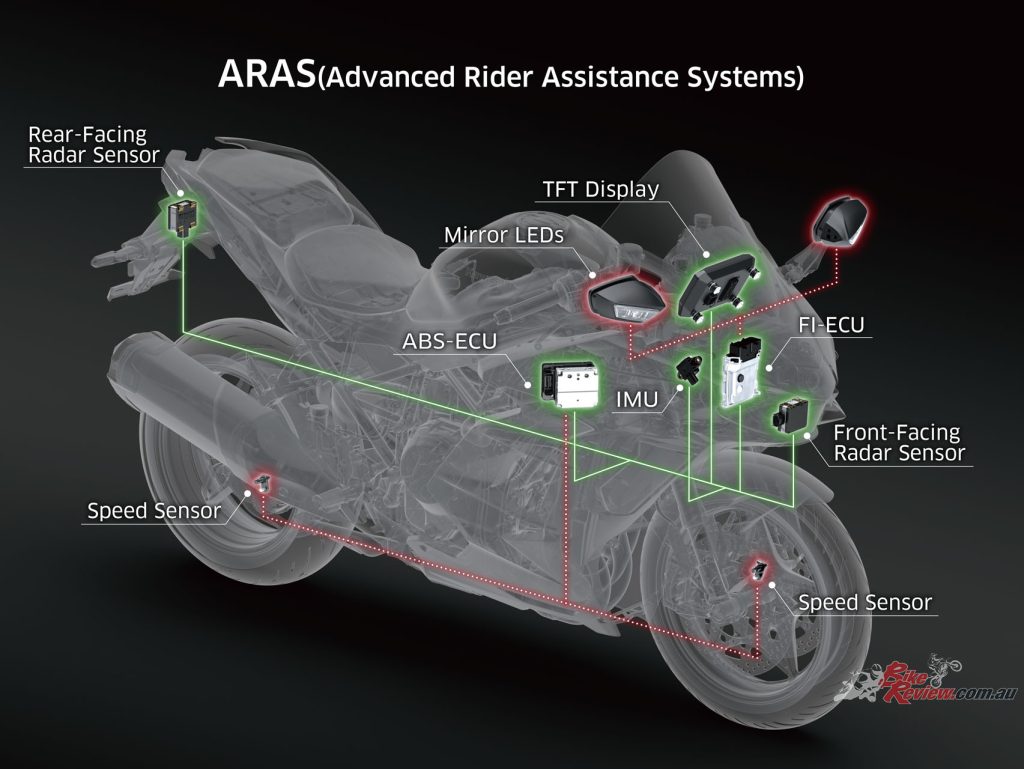
“The Ninja H2 SX is Kawasaki’s first model to integrate an FI-ECU with torque-demand capabilities; new IMU that measures in six DOF; and a compact, boost-circuit-equipped ABS with high computational power.”
IMU (Inertial Measurement Unit) enables inertia along 6 DOF (degrees of freedom) to be monitored. With the new unit, acceleration along longitudinal, transverse and vertical axes, plus roll rate, pitch rate and yaw rate are all measured (previously, yaw rate was calculated). Feedback from the IMU is used to give a clearer real-time.
A more advanced version of Electronic Cruise Control, ACC maintains the speed set by the rider, but adjusts the vehicle speed to maintain a suitable following distance from the vehicle in front. Front-facing radar sensor uses millimetre-wave radar to scan ahead in the rider’s lane. (The radar scans in a narrow path to focus on targets in the same lane.) The ABS-ECU obtains information from the radar, IMU, FI-ECU (front/rear wheel speed), as well as the instrument panel (rider-selected distance setting). When the distance to the vehicle in front is deemed insufficient, the ABS-ECU directs torque to be reduced.

Emergency Stop Signal identifies sharp braking and will flash the tail light to gain the attention of drivers behind.
When the system determines that continuing at the current speed may result in a collision with the vehicle in front, it warns the rider. Front-facing radar sensor monitors the distance and speed of the vehicle in front. When a vehicle is in close proximity and there is danger of a collision should the current speed be maintained, the system alerts the rider using a bright flashing red LED light above the instrument panel. A warning is also shown on the TFT display.
The rear-facing radar sensor monitors the bike’s surroundings and alerts the rider to presence of a vehicle approaching in the rider’s blind spot. Rear-facing radar sensor scans behind in the lanes to the left and right of the rider. When an approaching vehicle is detected, an LED built into
the rearview mirror will light up. (While common in the automotive world, this is the first use of mirror LEDs in the motorcycle industry). Should the rider indicate the intent to change lanes by switching on their turn signal while a vehicle is detected in a blind spot, the mirror LED will flash.
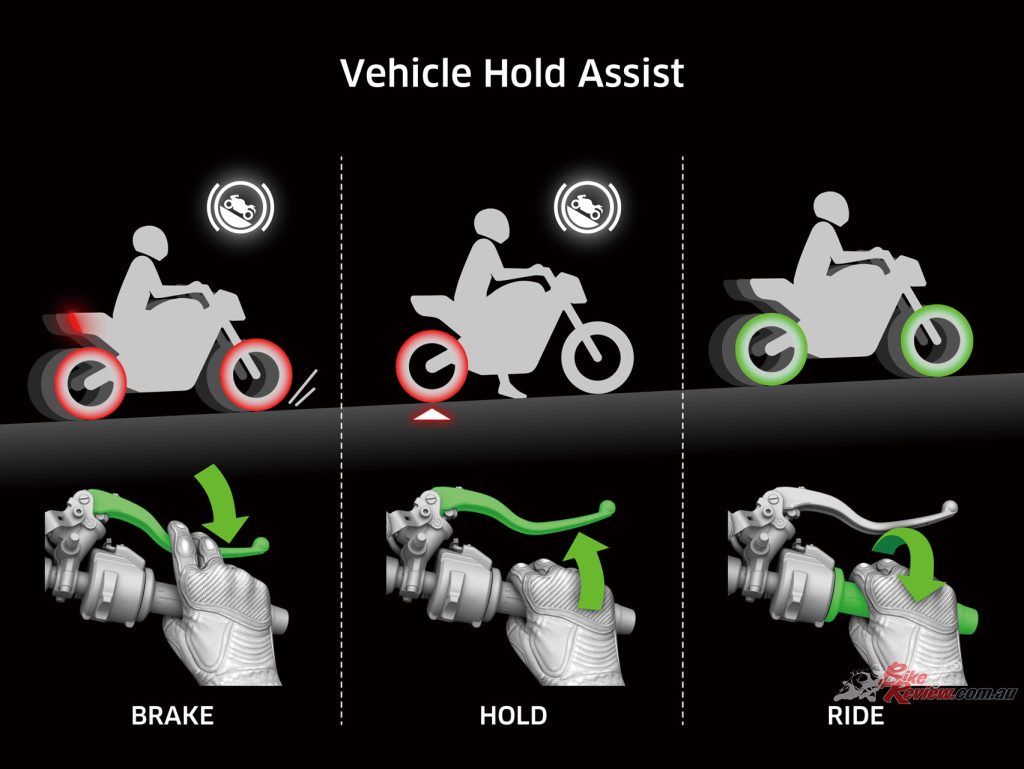
“Activated when the rider has stopped and firmly applies the brake(s), VHA (Vehicle Hold Assist) engages the rear brake to allow the rider to relax their brake hand.”
Activated when the rider has stopped and firmly applies the brake, VHA (Vehicle Hold Assist) engages the rear brake to allow the rider to relax their brake hand. In addition to brake fluid pressure, the ABS-ECU examines information from the IMU (degree of road slope) and FI-ECU (front/rear wheel speed, throttle position, and side stand switch) to determine whether operation conditions have been met.
When the rider has stopped, VHA is initiated after the rider exerts a given amount of pressure (to either the front and/or rear brake). The ABS pump exerts pressure to engage the rear brake, and a light/signal is indicated on the instrument panel to let the rider know that they can relax their brake hand and the bike will remain in place. The system disengages automatically when the rider turns the throttle to accelerate, when the side stand goes down, or 10 minutes after activation. The rider can also disengage the system by quickly squeezing and releasing the brake lever (within 1 second).
The other systems which were standard on previous year model H2 SX’s are also on the 2022 model. Including: Emergency Stop Signal, KCMF (Kawasaki Cornering Management Function), KTRC (Kawasaki Traction Control), KLCM (Kawasaki Launch Control Mode), KIBS (Kawasaki Intelligent anti-lock Brake System), Kawasaki Engine Brake Control, Power Modes: Full, Middle and Low and Integrated Riding Modes: Sport, Road, Rain, Rider (manual).
2022 Kawasaki H2 SX Specifications
Kawasaki.com.au
Price: $35,947 rideaway
Warranty: Two-years unlimited km
Claimed Power: 147kW[200hp]@11000rpm
Claimed Torque: 137.3Nm@8500rpm
Wet weight: 267kg
Fuel Capacity: 19L
Fuel Consumption: 6.7-7.5L/100km
Engine: Liquid-cooled, transverse-four, DOHC, 16 valves, 998cc, 76 x 55mm bore x stroke, 11.2:1 compression ratio, dual injection 40mm throttle-bodies, Kawasaki supercharger, KTRC, KLCM, KEBC, QKS, Gearbox: Six-speed with quickshift Clutch: Wet multi-plate slipper
Chassis: Trellis, high-tensile steel, with Swingarm Mounting Plate
Rake: 24.7, Trail: 103mm
Suspension: 43mm inverted fork with rebound and compression damping and spring preload adjustability, and top-out springs, 120mm travel, New Uni Trak, gas-charged shock with piggyback reservoir, compression (high/low-speed) and rebound damping adjustability, remote spring preload adjuster, and top-out spring, 139mm travel.
Brakes: KIBS, dual 320mm rotors, Brembo radial four-piston calipers, single rear 250mm rotor, twin-piston caliper
Wheels & Tyres: Cast aluminium star-pattern five-spoke wheels, 120/70 x 17in, 190/55 x 17in.
Dimensions:
Wheelbase: 1480mm
Ground clearance: 130mm
Seat height: 835mm
Overall height: 1260mm
Overall length: 2175mm
Overall width: 790mm
Instruments & Electronics: Full TFT display,
Editor’s Note: If you are reading this article on any website other than BikeReview.com.au, please report it to BikeReview via our contact page, as it has been stolen or re-published without authority.
The Verdict | Review: 2022 Kawasaki Ninja H2 SX


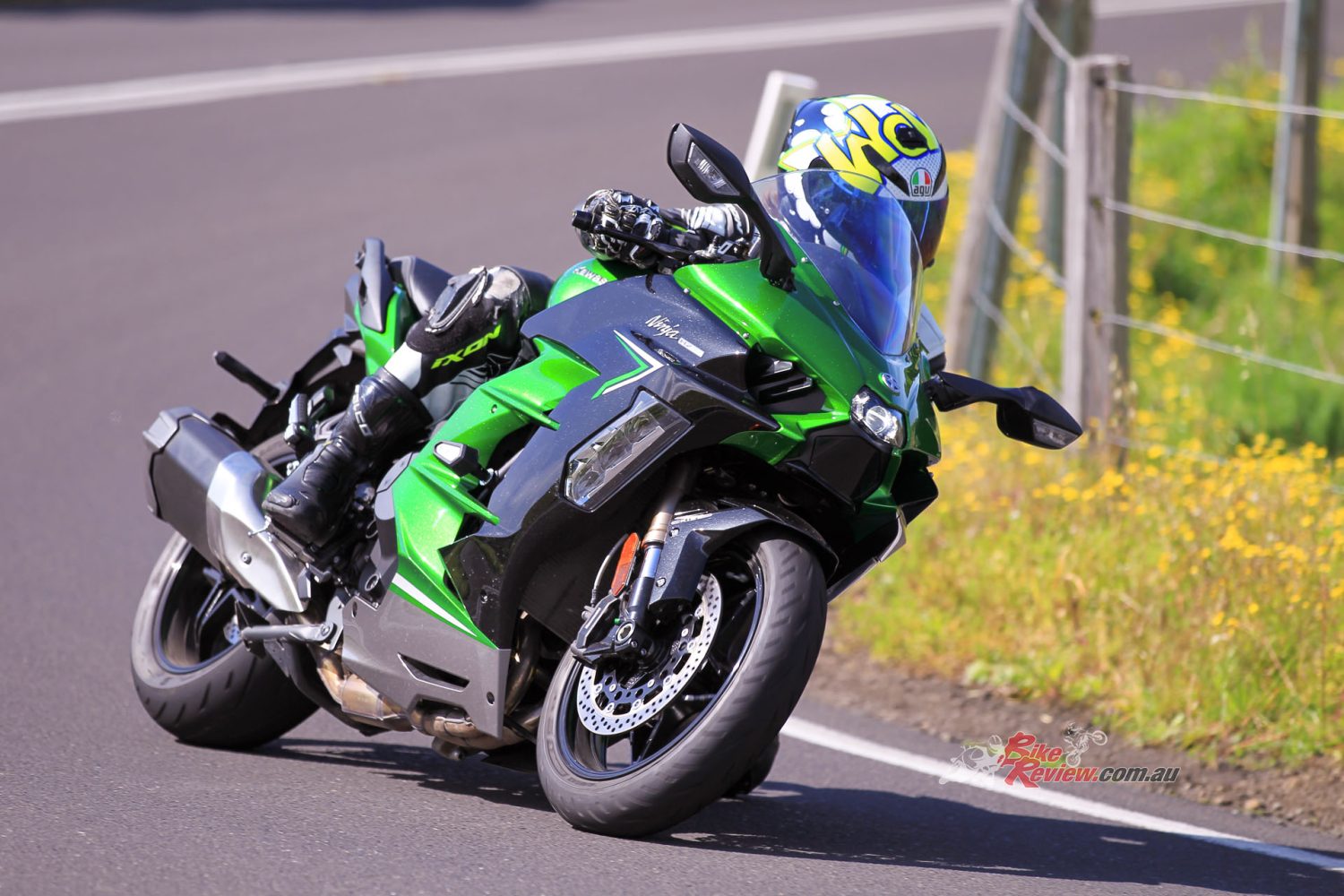
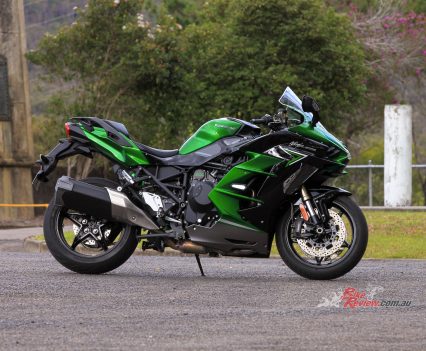




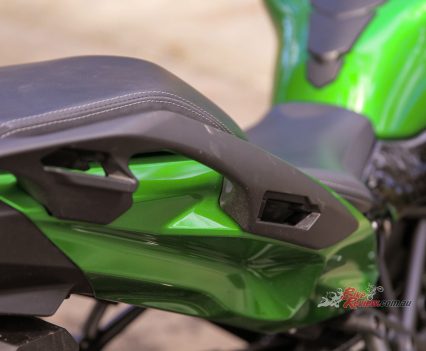


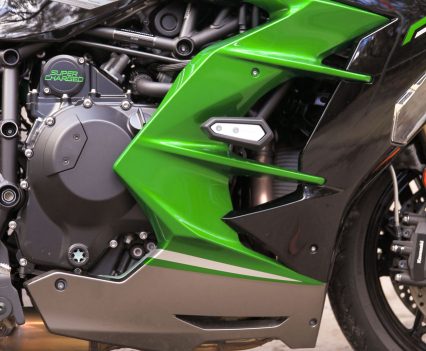
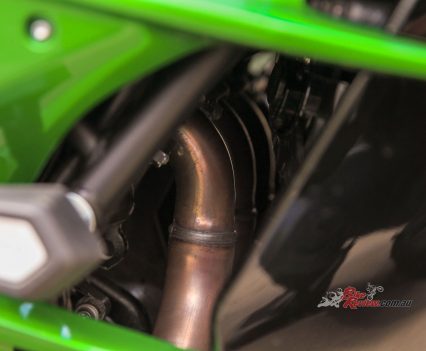







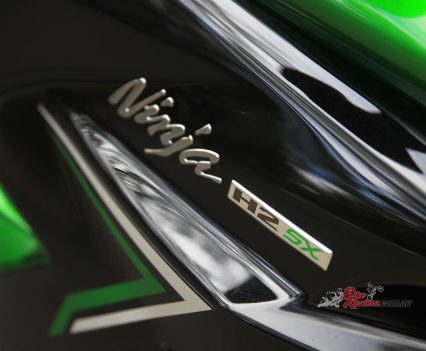


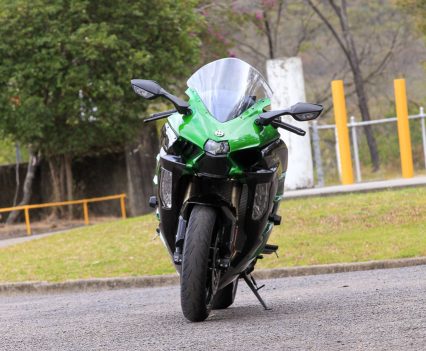

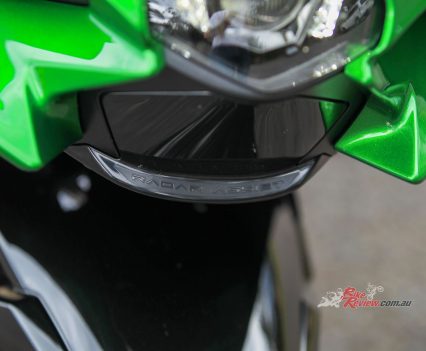








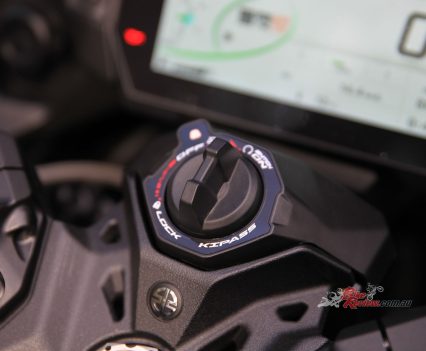





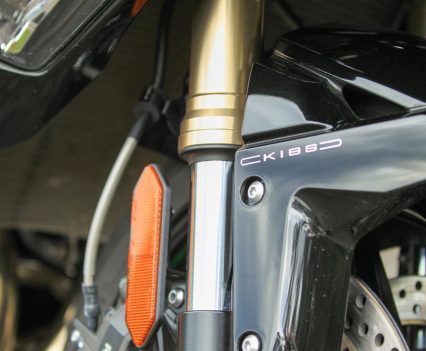


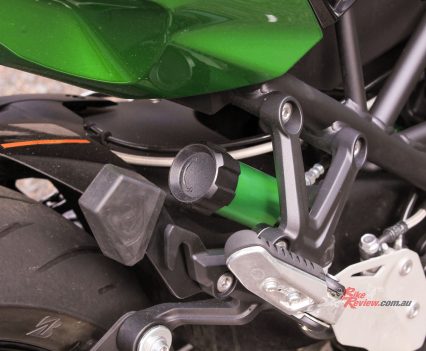











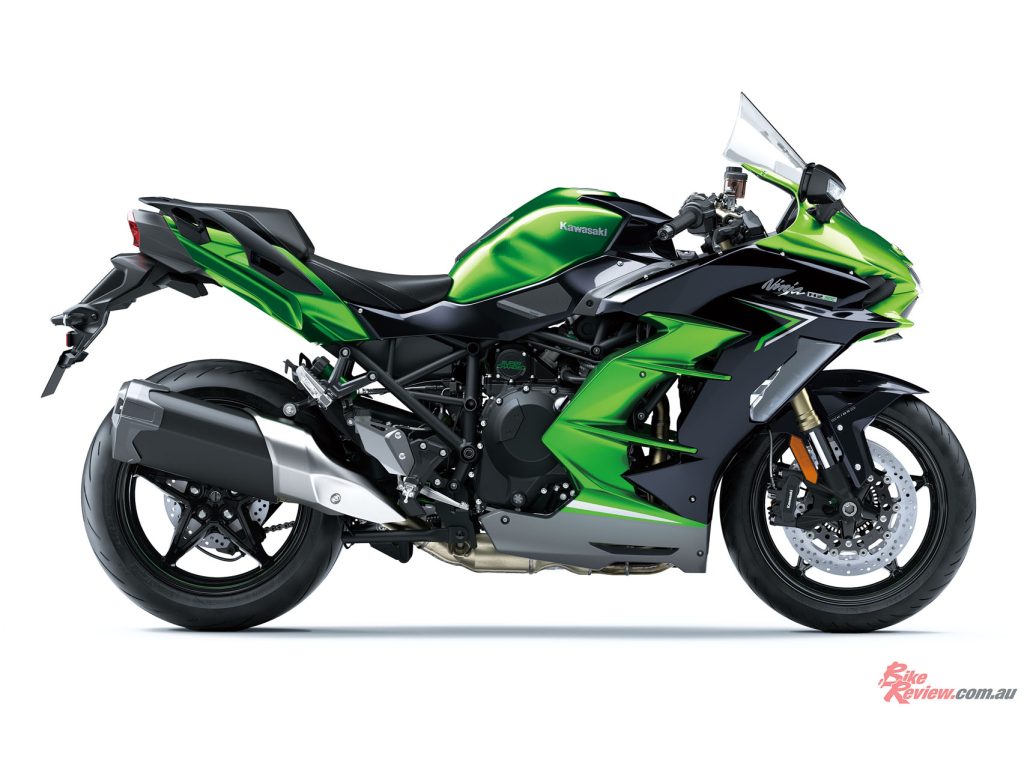

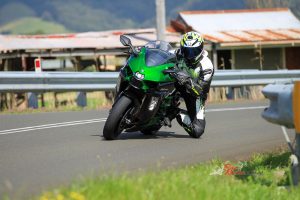

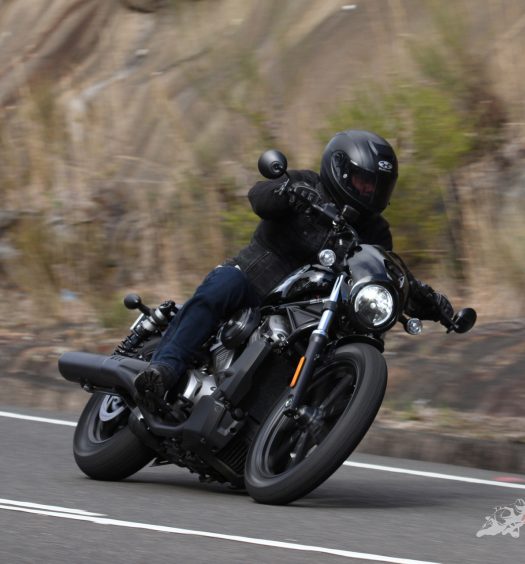






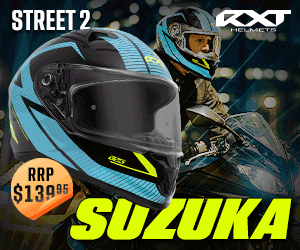







September 26, 2022
Fantastic review Zane. I’m now a proud owner myself of one of these sensational beasties and you’re right on the money mate about the sheer awesomeness of this critter.
I guess to be able to say such lofty praises one would need to have some pretty extraordinary examples to compare the big Kwaka to. Well,for the last 22yrs or so I’ve been dabbling around with “all things Hayabusa” namely owning 3 and 1 sensational B-King. (the massive power and torque those monsters produce is positively intoxicating)…..and the sad reason I’m still not riding the Busas today is probably a story for another day.
I’m now truly totally besotted with this amazing H2 SX although the vast amounts of electronics and gadgetry ,I have to admit, is somewhat overwhelming (Dang…the owners manual is 294 pages long ) and old school types like me are pretty easily bamboozled with all this hi-tech mumbo jumbo. One spot of relief to my constant state of confusion is that my nephew’s 5 year old son is always prepared when they’re visiting,to help out “Uncle Frank” with getting his head around the complexities to modern tech.
I guess still in these early days of getting to know all about the mighty Kwak is how very very different it makes it’s monster power compared to the Busas. Where the Busas are simply making humongous amounts of raw muscly power and torque like a runaway freight train…the SX is so very very smooth and turbine like where the supercharged drive comes on instantly and you totally feel as if you’ve just gone to “Warp Factor Nine” on the Enterprise. What a rush!
Cheers
Franko
PS: G’day Jeff…..must try and have a catchup one day.
October 18, 2022
G’day Frank!
The ‘Busa and H2 are both such awesome bikes. The 2022 H2 SX completely blew me out of the water!
I agree that the electronics on some of the bikes are a bit of a pain to use, even when I went to pick it up they handed me the owners manual and told me to give it a read through!
Over time you’ll get used to it though, it’s still not as complicated as some of the other bikes on the market but once you find those perfect settings, there’s almost no need to change anything.
Thank you for the kind words.
-Zane